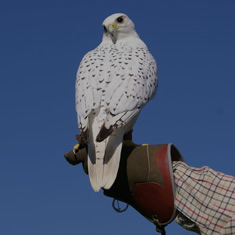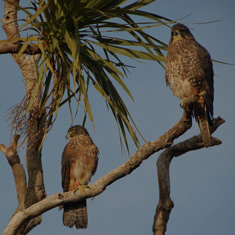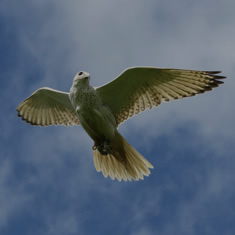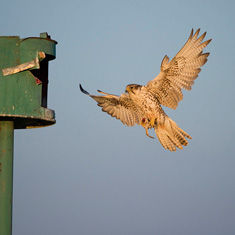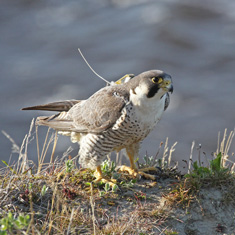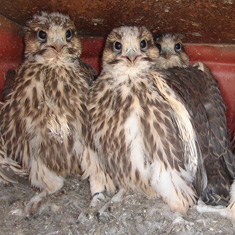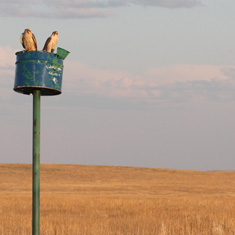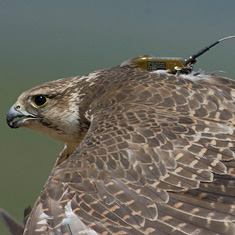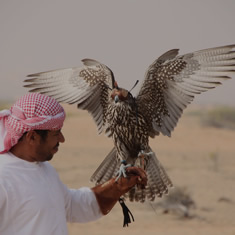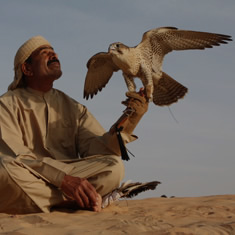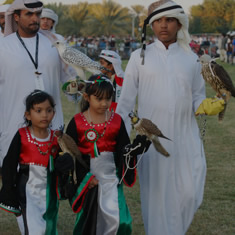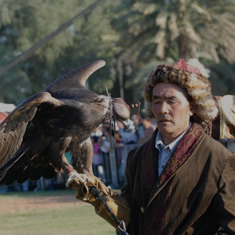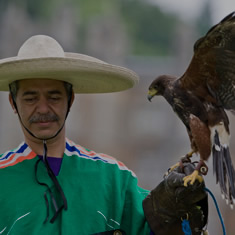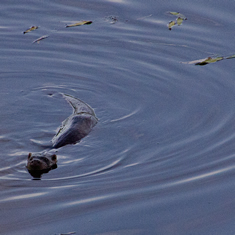- Mauritius Kestrel
By Nick Fox BSc, CEd, PhD, RF, Project leader
Barbro Fox, BEd, Research assistant
Tom Bailey, Research assistant
The Peregrine Fund, Inc. Laboratory of Ornithology, Cornell University, Ithaca, New York 14850, USA financed this research.
*This report is an unpublished draft manuscript copyright the senior author, who accepts responsibility for statements made therein.
- 1.1 The distribution of potential habitat for kestrels
- 2.1 Habitat survey
- 2.2 Method
- 2.3 Results
- 2.4 Open ground
- 2.5 Acacia scrub
- 2.6 Lowland exotic forest
- 2.7 Scrub
- 2.8 Semi-scrub
- 2.9 Degraded indigenous forest
- 2.10 Full indigenous forest
- 2.11 Rocks
- 2.12 Results
- 2.13 Deterioration of the indigenous forest
- 2.13a Natural degradation
- 2.13b Unnatural degradation
- 2.13c Destruction
- 2.14 Forest conservation
- 3.0 To assess which areas currently hold kestrels
- 3.1 Methods
- 3.2 Results
- 3.3 Nest site selection
- 3.3a Protection from the sun
- 3.3b Protection from prevailing winds
- 3.3c Protection from cyclones
- 3.3d Protection from predators
- 3.4 Factors affecting the distribution of kestrels
- 3.4a Availability of hunting habitat
- 3.4b Availability of nest sites
- 3.4c Climatic variables
- 3.4d Proximity to man
- 3.5 The current status of the kestrel
- 3.6 The total known population
- 4.0 Habitat utilisation by kestrels
- 4.1 Introduction
- 4.2 Detailed method
- 4.2a Radio-tracking - theory
- 4.2b Radio-tracking - technique
- 4.3 Definitions of terms used in time budgeting
- 4.4 Results
- 4.5 Territorial data
- 4.6 Hunting ranges
- 4.7 Range sizes
- 4.8 Incubation
- 5.0 Hunting methods
- 5.1 Method
- 5.2 Definitions
- 5.2a Search techniques
- 5.2b Attack techniques
- 5.3 Results
- 5.4 Comparison of observed attacks versus nest deliveries
- 6.1 Analyses of hunting data
- 6.2 Hunting success
- 6.3 Hunting intensity
- 6.4 Family needs
- 6.5 Predation pressure
- AN OUTLINE FOR FURTHER FIELDWORK
SUMMARY [top]
Fifty-five km2 of the Black River Gorges area of Mauritius were surveyed for plant cover and contained 160 ha (3.2%) open ground, 985 ha (19.6%) acacia scrub, 705 ha (14%) exotic forest, 431 ha (8.6%) scrub, 846 ha (16.8%) semi-scrub, 562 ha (11.7%) degraded forest, 1286 ha (25.6%) full indigenous forest and 53 ha (1.1%) rocks. Only 150-200 ha (3.5%) of the area is considered to hold regenerating indigenous forest, and the possible reasons for the deterioration of forest in the Gorges are examined.
Locations of 16 resident pairs of wild kestrels are documented together with the production of at least 11 young. The wild population is estimated at about 50 individuals. Reproductive success was 2.0 young per pair for 6 successful pairs of 8 pairs studied in some detail. Parameters affecting nest site selection, predation on, and distribution of kestrels are examined. Seven time budgets of radio-tracked kestrels are tabled giving details of nest-related activities, incubation, territorial and predatory activities in relation to habitat zones, and segmented by hour block. Incubation patches of 12 kestrels are illustrated. Hunting range sizes varied from 44.6 to 74.5 ha—mean 59.8 ha (n=7). Hunting methods were defined, and 63 attacks by wild kestrels analysed. Twenty-one prey items identified in these attacks were compared with 103 prey items identified in nest deliveries. Relationships in hunting success, hunting intensity, and family needs are examined briefly. Seventeen tables and 44 maps or figures are included.
INTRODUCTION [top]
The Mauritius kestrel is rare. Although estimates have been as low as 5-6 birds, these are probably more a measure of our ignorance than of the population. Such low numbers would be exposed to the dangers of inbreeding, and some signs in captive birds indicated that this might be so (Cooper 1979, Cooper et al. 1981). So gloomy was the prognosis that some conservationists felt that the Mauritius kestrel should be abandoned as hopeless; however, the struggle has continued. Carl Jones in his MSc thesis (1985) has documented what was known of the wild population prior to our study, and he succeeded during our visit in breeding five birds in captivity. Our study indicates that there may be about 50 birds in the wild; whether or not this apparent increase is real is unknown.
Surprisingly there are few hard data on the ecology of the Mauritius kestrel and the factors surrounding its decline. Our study therefore set out to collect basic ecological data on which to base further conservation efforts. It covered the period 5th October 1984 to 30th January 1985 and was undertaken by Dr. Nick Fox and two research assistants, Mrs. Barbro Fox and Mr. Tom Bailey. We hope to undertake one more four-month field study, and this interim report, apart from informing the various organisations involved of our activities, is an invitation to give criticism, advice, or suggestions for further lines of research which could profitably be incorporated into the study. For reasons which will become apparent in this report, the Mauritius kestrel is an excellent study species. We are able to examine quantitatively many aspects of the ecology of predation which have so far been poorly documented and which have implications for predation ecology as a whole.
First we set out to survey those areas of Mauritius with potential habitat for kestrels. This survey so far has covered about 55 km2 which hold all the known pairs.
Then we radio-tracked five wild breeding kestrels and mapped their ranges. We also recorded time budgets for the birds to examine their selective use of habitat in time terms. We would like to increase the number and duration of these studies next season, as many useful relationships can be derived from them provided the samples are large enough.
These studies of kestrels in both indigenous and exotic habitats enable us to define fairly precisely the habitat needs of breeding kestrels and to make projections both geographically in terms of other habitat areas and in time by looking at the pressures on the forest and assessing the rate of habitat loss. From them we can also predict the possibilities and likely consequences of releases of captive-bred birds.
ACKNOWLEDGEMENTS [top]
Carl Jones has been of inestimable help to us through all stages of the project right down to arranging transport and housing. Wahab Owadally, Conservator of Forests, has helped smooth the path of bureaucracy for us. Wendy Strahm kindly checked through our plant species lists. Mr. John Cooper during his three-week visit gave us useful discussions and advice, as did David Todd. The lessees of the chassees, Maurice Speville, Maurice Kbenig, and Dr. Rivelland, were most helpful in allowing us access and in providing information on kestrel sightings. Thanks are also due to Tom Gardner, Dr. Shuja, Yousouf Mungroo, and Cecilia Lindberg. The Gardner, Cooper, and Jones families did much to make our visit to Mauritius enjoyable.
Financial support was provided by The Peregrine Fund. Inc. through Prof. Tom Cade for Dr. and Mrs. Fox. Tom Bailey funded himself, and we are most grateful to him for his excellent and enthusiastic assistance. The Mauritius Wildlife Appeal Fund at short notice, kindly supplied us with a trailbike which enabled us to do most of the fieldwork.
1.1 The distribution of potential habitat for kestrels
Since the early eighteenth century when Mauritius became permanently colonised the indigenous forest has been logged until only the inaccessible mountain areas still have forest cover (Fig. 1.1). Parts of the Black River District and the Bambous Range (Fig. 1.2) are the only areas left that appear capable of holding self-sustaining populations of Mauritius kestrels. These areas total 161 km2 (8.6% of the Mauritius land area), but probably only one third of these areas are of sufficient quality to support breeding pairs. The Grande Gorge, for example, is now predominantly Chinese Guava Psidium cattleianumf and large areas of the Bambous have become Ravenala madaqascariensis forest.
The forest of Mauritius can be examined in two ways. Firstly the forest can be described in terms of indigenous forest types which are the result of the ecotype and which have probably been the same for many thousands of years. Secondly the forest can be described in terms of structure. Since man came to Mauritius the forest has been systematically logged, cleared, and infested with exotic species; it is no longer in its primeval structural state, although the majority of the original species are still present. The forest now is rapidly deteriorating in structural terms, and in many areas the degradation has reached the point at which not only has the structure been lost but the indigenous species themselves are disappearing. While the loss of indigenous forest area has been described by Vaughan and Wiehe (1937), there are no surveys documenting the deterioration of the last remaining pockets of indigenous forest, of which the majority is found in the Black River District. Such a survey is vital both for land management and also to understand which areas of forest are useable by kestrels. Aerial photographs are of use as historical records only where backed up by ground surveys describing the structure of the forest under the canopy.
The survey data were gleaned by walking through the forest in the course of kestrel fieldwork and mapping the habitat types onto 1:10,000
Figure 1.1 Areas under indigenous forest in 1773 (after Desroches), 1835 (after Fraser), 1872 (after Gleadow 1906) and 1935, from Vaughan and Weihe (1937).
Figure 1.2 Areas of Mauritius containing habitat which potentially might be suitable for kestrels.
Aerial photos by Hunting Surveys Ltd 1975 Photographs were taken inside the various types of forest with a one-metre scale included in each. Illustrations were then prepared from these photographs, and canopy data etc. measured for the tables. Climate data are from Padya (1984) for the nearest weather stations of similar climate to the forest type concerned, and soil data are based on Vaughan and Wiehe (1937). Color photographs of the Gorges area have been retained for reference.
The indigenous forest in the Black River area consists of three main types: Lowland Forest (usually in areas below 365 metres ASL and with an annual rainfall under 2500 mm), Upland Forest (usually above 365 metres with an annual rainfall over 2500 mm), and Dwarf Upland Forest which is found primarily on the poor soils of the Plaine Champagne. The components of these three forest types are given in tables 2.1, 2.2, and 2.3.
Within their own areas these three indigenous forest types have degraded to a greater or lesser extent or, in many areas, are gone completely and replaced by exotics. The habitat survey was therefore intended to show where the indigenous forest is, what structural state it is in, and in the places where it has gone, what has replaced it. This has required the recognition of more or less arbitrary categories which have been chosen as representing stages in the process and because they are importantly different from the point of view of the needs for hunting by kestrels. It turns out for example that, provided sufficient geckos are present, kestrels are concerned more with the structure of the forest than whether or not it is indigenous.
The results of the survey of forest structure are accurate to about +5% of the horizontal land area, but because of the exponential increase in surface area with gradient, the contour map (Fig. 3.2) should also be kept in mind. The categories are:
a. Open ground e. Semi-scrub
b. Acacia scrub f. Degraded indigenous forest
c. Exotic forest g. Full indigenous forest
d. Scrub h. Rocks
All area symbols are based on North being at the top of the page.
These are usually areas of otherwise fertile ground 0.2 - 12 hectares (0.44 - 26.4 arpents approximately) artificially kept clear of trees, usually to provide grazing for deer and sometimes to provide a clear line of fire for driven deer shooting. Such areas are distributed throughout the Gorges wherever deer are managed. Apart from occasional single or small groups of trees (>50 metres apart approximately), normally of species representing the previous forest cover, there is no vegetation over 30 cms. high. Grass species include Bothriochloa pertuse. Heteropogon contortus. Panicum maximum, and Thedema quadrivalvis. These areas are commonly frequented by deer Cervus timorensis. monkeys Macaca fascicularis, mongooses Herpestes edwardsii. black rats Rattus rattus. brown rats R. norvegicus. shrews Suncus coerulus. hares Lepus nigricollis. tenrecs Centetes ecaudatus. Madagascar doves Streptopelia picturata. spotted doves Streptopelia chinensis. barred ground doves Geopelia striata. common mynahs Acridotheres tristis. red-whiskered bulbuls Pycnonotus jocosus and weaver-birds Ploceus spinolotus. Those near the mouth of the Gorges also contain helmeted guinea-fowl Numidea meleactris.
Gecko densities are very low in these grasses.
Details of acacia scrub are in Table 2.4 and Figure 2.1. Acacia scrub represents an exotic habitat used for deer raising. It covers large areas of ground between the Gorges and the sea, and compared to the habitat it replaces it represents the first stage towards desertification.
TABLE 2.4 ACACIA SCRUB
Soil Type Rough broken lithosols
Altitude Ubiquitous distribution, generally found in lowland
>200 m Annual Temp. Range Medina (91 m) Mean 26.9° C Jan - mean 21.3° C July
Annual Rainfall >2000 mm
Ground Cover Grasses, eg Bothricohloa pertusa
0.5 m Heteropogou contortus
Panicum maximum Thedema quadrivalvis
Shrubs and Trees Cassie Acacia farnesiana
Cassie Blancs Leucaena leucocephele
Bois Noir Albizzia lebbeck
Jamlong Eugenia jambolana
Campeche Haematoxylon campechianum
Cassie Manille Pithecolobium dulce
Bois Savon Sapindus trifoliate
Tamarind Tamarindus indicus
Aloe Furcraea foetida
Canopy Height None
Approximate Deer H Echo Parakeets A
Vertebrate Pigs L Ring-Necked Parakeets L
Numbers Monkeys H Paradise Flycatchers A
Mongoose H Madagascar Turtle-Doves H
Rats H Spotted Doves H
H=High Shrews H Barred Ground Doves H
M=Medium Hares H Cuckooshrikes A
if=low Tenrecs H White Tropic Birds present
A=Absent Fruit-Bats L-A Pink Pigeons A
Toads L Olive White Eyes A
Mynahs H Red-Whiskered Bulbuls H
Picpics H Merles A
Feral Cats M Feral Pigeons A
Guinea Fowl L Weaverbirds H
Gecko spp Phelsuma ornata ornata
present
Details of lowland exotic forest are in Table 2.5 and Figure 2.2. These are primarily areas where the indigenous forest has been destroyed so long ago that exotic trees have colonised and created patches of exotic woodland, particularly in areas too damp for acacia, such as in the Gorges or along watercourses. Some, such as the Terminalias, were planted after World War I to stabilise the river-beds, some, such as tecoma, are probably self-sown and unevenly distributed. These exotic trees share one factor lacked by the indigenous trees, namely that they can replace exotic scrub such as guava and privet.
As it matures and forms a canopy the exotic woodland in the Gorges holds sufficient numbers of huntable geckos to support kestrels (see data on the Mt. Zaco pair), and those below Maccabe and in the Manava junction were frequently visited by echo parakeets Psittacula echo and, of course, large numbers of ring-necked parakeets Palaeornis torouata.
TABLE 2.5 LOWLAND EXOTIC FOREST
Soil type Rough broken lithosols
Altitude >350 m ASL
Annual Rainfall 1000-2500 mm
Annual Temp Range Mediae (91 m) Mean 26.9° C Jan - mean 21.3° July.
Ground Cover Grasses; eg: Stenotaphrum dimidiatum
0-0.5 m Panicum spp
Madagascar Periwinkle Catharanthus roseus
Asclepias sp Canavalia maritima
Songe Noire Colocasis exillente
Shrubs Aloe Furcraea foetide
0.5 - 7.0 m Guava Psidium guyava
Psidium cattleianum
Privet Ligustrum robustum/valkeri
Liane Cerf Hiptage benghalensis
Poivre Marron Schinus terebenthifolius
Framboise Rubus spp
Vieille Fille Lantana camara
Acacia Leucaena leucocephala
Yatis Litsea roonopetala
Cassie de Manille Pithecellobium dulce
Acacia fames iane
Trees Mango Mangiferea indica
7.0 m Bois Noir Albizzia lebbeck
Tecoma Tabebuia pallida
Jamrosa Suzygium jambos
Bois d'Oiseaux Litsea glutinosa
Eucalyptus Eucalyptus spp.
Filao Casuarina eguisetifolia
Terminalia Terminalia spp.
Canopy Height 7.0 - >20 m
% Canopy 100-60%
Approximate Deer H Echo Parakeets L-A
Vertebrate Pigs M Ring-Necked Parakeets H
Numbers Monkeys H Paradise Flycatchers A
Mongoose H Madagascar Turtle-doves H
Rats H Spotted Doves H
H=High Shrews H Barred Ground Doves H
M=Medium Hares H Cuckoo shrikes A
L=Low Tenrecs H White Tropic Birds present
A=Absent Fruit Bats H-M Pink Pigeons A
Toads H Olive White Eyes A
Mynahs H Red-Whiskered Bulbuls H
Pic Pics H Merles A
Feral Cats M Feral Pigeons A
TABLE 2.5 cont. LOWLAND EXOITC FOREST
Gecko spp. Phelsuma guliribeaui prefers clumps of large shady
present trees.
Phelsuma cepediana
Phelsuma ornata abundant in all forms of
scrub and trees.
Calotes versicolor Agama Lizard
A variety of common scrub species in the Gorges is shown in Table 2.6. Scrub represents the final degradation of the indigenous forest. Through logging, lack of regeneration or through competition, the last remnants of the native forest have disappeared to be replaced by dense scrub thickets. In places where soils are thin, such as ridges, guava out-competes with the indigenous vegetation. Consequently ridge lines, for example along the west ridge of Piton de la Riviere Noire, often show monotypic stands of dense 1-3 metre guava.
In more fertile areas guava, as it grows up and thins out in the bottom, can eventually be replaced by exotic trees. Meanwhile all forms of scrub, although harbouring very low numbers of geckos, are far too dense for the kestrels to hunt effectively, and such areas are lost to the falcons. Prey caught there are invariably taken on the occasional bare rocks or relict solitary trees.
Our category 'semi-scrub1 indicates areas in which scrub is so dominant that the indigenous trees can no longer be described as forest. There is no canopy, just isolated trees usually about 30-50 metres apart, many of which are in a poor state of health. Some are old cyclone-damaged giants now failing, others are stunted younger trees being overtaken by the scrub in the race for light and nutrients. Because these trees are relatively exposed, the kestrels are able to take geckos living on their branches. On two occasions when this was attempted the gecko was knocked off the branch and was lost in the sea of scrub below.
The composition of species in semi-scrub varies according to locality. Essentially it is that of the appropriate indigenous forest (see Tables 2.1-3) being overtaken by scrub (Table 2.6). Figure 2.3 illustrates a fairly typical example.
TABLE 2.6 SCRUB
Edaphic and climatic factors all vary according to the altitude and location of the scrub area and are therefore so variable as to be undefinable.
Continuous Vieille Fille Lantana camara
scrub Framboise Rubus spp
layer Arbre de Noel Ardisia crenata
<7 m Longouze Hedychiuin spp
Grasses
Ferns
Guava Psidium cattleianum
Privet Ligustrum robustum/waHceri*
Poivre Marron Schinus terebenthifolius**
Aloe Furcaea foetida
Liane Cerf Hiptage benghalensis**
Yatis Litsea monopetala
* predominantly found in upland scrub areas ** only found in lowland scrub areas
Canopy There is no canopy except among stands of 'Yatis1
which may form a canopy of height 5-7 m.
Approximate Deer H Echo Parakeets A
Vertebrate Pigs M Ring-Necked Parakeets L
Numbers Monkeys M Paradise Flycatchers A
Mongoose H Madagascar Turtle-Doves L->A
Rats M Spotted Doves L->A
HMHigh Shrews M Barred Ground Doves L->A
M=Medium Hares A Cuckcoshrikes A
L=Low Tenrecs L White Tropic Birds present
A=Absent Fruit-Bats A Pink Pigeons A
Toads M Olive White Eyes A
Mynahs M Red-Whiskered Bulbuls H
Pic Pics L Merles A
Feral Cats L Feral Pigeons A
Gecko spp. Phelsuma ornata ornata
2.9 Degraded Indigenous Forest
This is taken as the intermediate grade between semi-scrub and full forest (Figure 2.4). It contains a substantial proportion of indigenous species 7-20 metres tall. The canopy is about 50%, leaving spaces which have been colonised by scrub species. Many of the indigenous trees are in reasonable condition but regeneration is being prevented by the scrub thickets. While it is hunted successfully by kestrels, only the upper stories are huntable owing to scrub growth. Some further areas, such as the north slope of Morne Seche, have been described as degraded because they are now heavily populated with exotic species, have a highly unbalanced age structure, and have little or no regeneration owing to the artificially high deer numbers.
The composition of the full indigenous forest has been described in Tables 2.1-3. None of these full forests are in their primeval state. All show varying degrees of structural degradation or infestation, (see Figures 2.5 and 2.6). In the lowland full forest guava is present and soon fills breaks in the canopy. In the dwarf forest there is often a short dense understory blanketing the ground. Although a few species are thought no longer to be regenerating, the full forest is still essentially functioning as an 'original' ecosystem with a high percentage canopy and a reasonable age spectrum. It is prime hunting habitat for kestrels, especially the large ie. lowland or upland forest.
The rock in the Gorges is of volcanic origin and contains small pockets and crevices which shelter geckos. The geckos venture out to catch insects on the open rock and are then vulnerable to kestrels. The rocks crumble easily into a poor soil, and there are no shingle fans or scree areas in the Gorges. Although various scrub plants encroach at the edges of the rocks, the rock habitat is esentially bare, exposed rock.
Figure 2.6 Full indigenous lowland forest.
The plant cover in the 55 1-km-grid squares so far surveyed are shown in the survey maps (Figures 2.7 - 2.13) , and the areas of habitat in each grid square are shown in Table 2.7. When interpreting these maps the following points should be borne in mind:
a). The Plaine Champagne is about 30-40% scrub or semi-scrub, but we have been unable to map these areas in detail and have somewhat optimistically rated it all as 'degraded’.
b). The dry acacia scrub country to the seaward side of the Gorges has not been surveyed in detail and is constantly changing owing to deer farming activities. Most of it is grossly over-grazed by deer, with little foliage below 2.5 metres (our illustration Figure 2.1 is a fenced-off sample); consequently this category is unstable and temporary and dependent on immediate land management policy. While the acacia scrub is unable to support breeding kestrels (see Tables 4.1 and 4.7) kestrels have been seen catching small birds there, and these areas may be of importance as buffer zones.
c). Rock areas are probably underestimated, possibly by a factor of two. This is because most of the rocks have a large vertical component but a small horizontal area.
d). Tracks and river-beds have not been separately measured in the area table (2.7) but have been integrated with adjacent zones.
e). For accuracy the survey has been based on the 1:10,000 aerial photographs rather than the 1:25,000 Ordnance Survey map. The aerial photo mosaic does not exactly align over the 10 North-South kilometres of our survey with the corresponding Ordnance map, and there is thus some discrepancy over the exact placement of the grid squares in the Tamarin Gorge area. If in any doubt about the exact positioning of each square, align our map with the geographical features on the Hunting Surveys 1975 photos, obtainable from the Housing & Planning Dept., Port Louis.
*Figures 2.9 - 2.13 of the original report have been omitted.
2.13 Deterioration of the indigenous forest
The history of the forest is written in the trees. Brouard (1963) has recorded man's part.
Three interacting factors are causing loss of indigenous forest in the Black River Gorges and adjacent areas:
a. Natural degradation.
b. Unnatural degradation.
c. Destruction.
2.13a Natural degradation
Natural degradation occurs in areas where the soil is thin and predominantly rock; the south basin on Brise Fer is a typical example. A natural progression from full forest to patchy forest to scrub and bare rock can be seen in such areas. Also, poor soils such as those of the Plaine Champagne support only stunted forest and, when cleared, remain as bare exposed earth for long periods. Examples of this can be seen on the Piton Plateau 400 metres west of the Jules Edouarde basin. Vegetation shadowing can be seen, locally on the relatively narrow ridges of the grande Gorge, and on a larger scale on opposite sides of Haccabe and Brise Fer; slopes facing north and west have a drier, more scrub-prone, cover than south and east facing slopes, which have deeper damp soil and support full forest. All these signs are indications that the full indigenous forest is reaching its natural ecological limit in certain parts of the Gorges and in those parts would not benefit greatly from conservation efforts.
Cyclones are an inherent part of the climate of Mauritius, and the indigenous trees are cyclone-adapted. Adaptations include root intertwining, buttressing, twisted-grained trunks, tough compact branches, and small, hard leaves. Provided that the forest remains reasonably healthy cyclones cause only local and temporary damage. Cyclones may exacerbate the deterioration in places where the forest is already highly degraded owing to other factors, but they are not a cause in themselves, otherwise the forest would never have grown in the first place. The Grande Gorge for example, now heavily degraded, once held full forest, tree remnants of which can still be seen.
2.13b Unnatural degradation
Deer (Cervus timorensis) were introduced in 1639 and by 1690 had spread to Black River. In the nineteenth century their numbers were so high that large herds crossing the road often blocked the passage of coach traffic (Owadally and Butzler 1972). The indigenous forest trees are not browse-resistant, and in areas where deer numbers are high (such as currently on the north slope of Morne Seche) the deer completely prevent regeneration. With the varying fortunes of the human colonisers, it is likely that the densities of deer have fluctuated considerably over the last three hundred years. In times when numbers were high all regeneration of native trees would have ceased; when deer numbers dropped, then limited regeneration would continue. One would anticipate, therefore, pulsing in the age spectrum of the indigenous trees above the cut lines and this does occur. It is most noticeable in those areas which would normally support full forest, for example the middle slopes of Vanillerie and (before it was cleared in Jan 1985) Jules Edouarde basins, the north slopes of Maccabe, and Brise Fer, and in Petite Gorge. In these places there are low-medium densities of large trees (mesophanerophytes, Vaughan and Wiehe 1941), then a big age gap before a layer of middle-aged merging (only in the best places) to young trees. We noticed this in several parts of the Gorges before discovering it documented in detail by Vaughan and Wiehe (1941; 126), who attributed it to the effects of monkeys which devastate the flowers. We believe that the browsing of seedlings (which represent the reproductive efforts of a much larger number of flowers over several years) has more impact than the destruction of the flowers or fruit by monkeys. However, our comments on deer populations could equally apply to the introduced monkeys, and it would be instructive to investigate the age structure of such species as Colophane Canarium peniculatum and Tambaloque Sideroxylon grandiflorum with the historical presence and densities of deer and monkeys.
Once regeneration has been reduced there is room for exotic invaders such as guava Psidium sjsp. to became established. Introduced about 1750, Chinese guava P. cattleianum was already forming a considerable proporation in some forests by 1880 (Thompson 1880), and Gleadow (1904) commented on the spread of Chinese guava over large areas of open scrub. He stated 'when growing pure it forms a dense low cover under which few of the better species exist'. Guava is now the predominant species in the Gorges in almost all habitat categories except acacia thorn scrub (too dry) and the best full forest. Take-over by guava has been rapid and widespread varying from dense, monotypic thickets of one-age stands 1-5 metres high, the commonest form of scrub and semi-scrub in the Gorges, and covering about 25% of the land area, to multi-age stands competing for light with existing degraded forest, often the guava being thin and attenuated but up to 10 metres high. The growth characteristics of Chinese guava are the key to understanding the degradation in the Gorges. Guava, and to a lesser extent, privet, has these properties:
i) Guava can grow in lower light conditions than natives,
ii) Guava grows faster than natives.
iii) Guava can grow in poorer, thinner soil than natives,
iv) Guava can grow in slightly drier conditions than natives.
v) Guava cannot grow as tall as natives.
Obviously we have not been able to conduct controlled experiments to prove these statements, but using the 55 km2 survey area as our laboratory it is possible to find areas where the experiments are occuring naturally and in which all the variables are constant except those under consideration.
i) Light The flat areas on Maccabe and Brise Fer still hold relatively good examples of full indigenous forest on soils of even depth and moisture. There the guava and privet have grown up under the canopy in lighting levels too low for natives to germinate, and they form dense thickets. This has lowered the lighting even further, as well as the available soil nutrients, reducing the regeneration of natives in the thickets to zero and effectively terminating the life of the native forest. Dr. Vaughan's study plot, now cleared by Wendy Strahm, is a striking contrast.
ii) Growth rates Examination of growth rings and leaders shows that guava in the Gorges is growing at about 25-35 cm per year, depending on the area. We have been unable to find data on growth rates of indigenous trees but one 60-cm diameter trunk we examined contained 80-90 growth rings which we presumed correspond to the annual wet and dry seasons. Undoubtedly, within the first 5 metres, guava is able to overtake and suffocate native trees very effectively.
iii) Soil quality The soil quality in the Gorges is low. Succeeding volcanic lava flows have flooded the plateau in the past. Sometimes in between the flows the forest has re-established itself, and the roots of tree ferns can be seen in the lateritic layers, for example in Manava Head cave. Over the plateau of Plaine Champagne the soil is immature and shallow, causing stunting. The indigenous trees grow there slowly, forming dwarf forest, but guava, which is also stunted, is able to out-compete the natives there. Although we have classed this area as 'degraded' (because we have been unable to map it in detail without helicopter) at least 30-40% of its area is scrub or semi-scrub owing to guava encroachment. Within the Gorges, where the soil gets thin over bedrock, guava and privet still grow, right up to the fissures in the solid rock. Going out onto the rock, the last secure handhold is usually a guava stem. Going down the Gorges to where the indigenous trees are giving way to exotic forest, guava is still to be found; it is able to exploit the full spectrum of altitudes and soils, whereas the indigenous species tend to be more specialised.
iv) Soil moisture Guava can grow in drier conditions than natives. In the Gorges vegetation shadowing is a very noticeable phenomenon. Slopes facing WNW tend to be covered with scrub or semi-scrub whereas other areas are forested (apart from those on poor soils or which have been destroyed). Examples of shadowing are the WNW slope of Piton de la Riviere Noire, all the WNW slopes along the south side of Grande Gorge from Riviere Roches Blanches to the entire head basin, the WNW head basins of Manava Gorge, Petite Gorge and upper slopes of Tamarin scarp. Shadowing can also be seen on a more miniature scale at the tops of the deep grooves on the south side of Brise Fer near the head of Manava Gorge. Shadowing does not normally occur where the angle of slope is less than 30° such as on the WNW faces of Maccabe, Brise Fer and the lower slopes of Piton de la Riviere Noire and the Tamarin Scarp, where the vegetation reverts to indigenous forest. Nor does it usually occur on slopes steeper than 40°, such as on the north and south sides of Brise Fer and the south side of Maccabe at the east end of Grande Gorge, because in those areas the entire slopes become scrub.
Two parameters work in the WNW-ESE direction: wind and rain. If the prevailing ESE winds were the cause of shadowing, first one would not expect a correlation with angle of slope. Second one would expect the forest to grow preferentially on the lee slope and not on the windward slope. Wind stunting does occur and can be seen on the WSW-ENE ridge above Morne Seche (marked on grid square 46), the small north facing spur on Brise Fer into Petite Gorge and the WSW-ENE ridge between Simonet and the Tamarin Gorge bluffs. In those cases a scale section of the ridge appears as in figure 2.14A. However, on the shadowed ridges the section appears as in figure 2.14B (location marked on grid square 65). One therefore concludes that as the rain drives down the Gorges all the lee slopes receive less rain and that all the steep and upper slopes lose more rain owing to run-off and that in those areas soil moisture is lower. The indigenous species, although they once colonised those areas, preferred the moister ground, and have given way on the drier ground to guava and privet scrub. Therefore, in the face of introduced competition, soil moisture has become a limiting factor in the poor soil areas of the Gorges for the indigenous forest.
v) Height Guava and privet seldom grow higher than about 7 metres. This means that they cannot suffocate existing full forest trees. Instead, they kill the forest by a process of attrition, preventing germination of seedlings, and suffocating and outgrowing any natives under about 5 metres. The entire Grande Gorge was once full forest - the remains of the trees can still be seen - now most of it is scrub or semi-scrub. In those areas designated semi-scrub there must be very few indigenous trees under 80-100 years old. This means that scrub infestation has prevented regeneration for the past 70-90 years there. In the better soils the native forest has been able to hold its own for longer but is now gradually succumbing where regeneration has stopped. Only about 150-200 hectares of indigenous forest in the Gorges is currently regenerating; this area represents about 10% of the existing full or degraded forest and about 4% of the Gorges area. The best pockets are parts of Maccabe, the upper northern slope of Brise Fer, the NW bottom of Brise Fer, and the slope linking squares 72 and 73. In about 50 years, therefore, the area of full or degraded forest will have dropped to 200 hectares split into three pockets. The dependence which the kestrel has on native forest is examined in detail in section 4; these last pockets could sarcely support 1-2 self-sustaining pairs.
Unless effective steps are taken to conserve the indigenous forest against unnatural degradation, the wild kestrel population will probably collapse before the middle of the next century. If human destruction is allowed to continue the demise will occur sooner.
2.13c Destruction
By 1880 the valuable trees in the Gorges had long since been worked out (Thompson 1880). This early logging was for prime timber extraction, whereas in recent times the clearing has been for deer pasture. Once the timber had been taken, the area was abandoned, and some regeneration took place, together with the beginnings of invasion by exotics. This is visible in the narrow age structure of the existing trees, very few trees over middle-age being present. Low regeneration in recent years has meant that the young age group is poorly represented too.
The timber clearing being undertaken at present is accomplished by dropping all growth under about 10 cm diameter, piling it into heaps of brushwood about 5 metres apart, and burning it. The remaining trees are those in the middle age group (about 10-30 cm diameter), many of which are destroyed by the burning brushpiles. After the ground has been cleared, it is kept clear by hand cutting and may be planted with forage grasses. In many areas of the Gorges, for example on both banks of Riviere Roches Blancs up to the cut lines, the cut over areas have been abandoned and have been taken over by exotic invaders such as guava, tecoma, or privet. Lower down the Gorge, stands of eucalyptus and tecoma have been encouraged and have been cleared out underneath. Owing to the increasing of deer stocking rates, the forest clearance has continued, even, during the survey, to within 50 metres of active kestrel nests (Site one and Stone Man).
To sum up what we believe to be the most effective ways of stemming the forest loss:
a. In full forest and degraded forest areas (see survey) stop further active destruction and selectively clear the denser stands of guava and other exotics, but not so drastically as to isolate the remaining indigenous trees and expose them to cyclones. Lower deer and monkey populations to levels low enough to permit active regeneration until a proper age structure is regained.
b. Areas of semi-scrub and scrub covering good soil would require the above treatment as well as replanting with indigenous seedlings.
At present the forest in the gorges is in a state of dynamic unbalance and the deterioration already mapped will continue unless active steps are taken to reverse it. Soon most of the areas listed as semi-scrub will become scrub, most of the degraded areas will become semi-scrub and those areas listed as full forest (in reality already 20-40% degraded) will degrade further. At this point, with no regeneration, the indigenous forest ecosystem collapses, as it already has done in most of Grande Gorge, taking with it the remaining endemic species dependent on it and completing the cycle begun by the Dodo. On the historical basis of the destruction of the forest, the laws relating to it and the effective measures so far taken to allay it, it is most likely that the Mauritius kestrel will soon became extinct in the wild; not because there will be no kestrels but because there will be no wild.
Jones (1985) located seven pairs of Mauritius kestrels in the wild in 1983. Of these, three pairs bred, three were thought not to have attempted breeding, and one was known only to exist. We checked these sites and searched the Gorges as closely as possible. We found all the territory-holding pairs between Mt. Zaco and Escalier along the western side of the Gorges, but the remaining area, particularly Grande Gorge, was not exhaustively covered. In addition to sightings, we radio-tracked seven breeding adults and plotted their ranges.
The combination of visual sightings and radio-tracking data produced a map of hunting ranges of 14 pairs shown in figure 3.1 and the map of distribution of nest sites shown in 3.2. The reproductive success of these birds is shown in Table 3.1. The details of radio-tracking technique and data analysis are given in section 4. 3.3 Nest site selection
Parameters which might affect nest site selection include:
a. Protection from the sun. c. Protection from cyclones.
b. Protection from prevailing winds, d. Protection from predators.
The directions faced by 12 known nest cavities are shown in figure 3.3. There is a preference for cavities facing north and west (P<0.001,x2 test). The two exceptions are Mt. Zaco, where two sites are on a marginal SW facing cliff, and Site One facing SE. These three sites have long tunnels (120 cms, Carl Jones pers. comm.) which presumably buffer the effects of the sun. Because of the latitude of Mauritius the positioning of the sun is not entirely straight forward. On 20th October the sun rises in the south, crossing to the north during 0800-1600, at which time its altitude is too high for the azimuth to be significant. By 3rd November the sun is in the south between 0900 and 1500, at which times its altitude is 47°. By 25th November - 20th January the sun shines from the south throughout the entire day. During the nesting season, therefore, the north and west faces have the shortest periods of solar heating.
Figure 3.3. The directions faced by Mauritius kestrel nests.
3.3b Protection from prevailing winds
The prevailing winds are from the southeast and therefore also correlate with nest direction; however, the winds are normally light, and by the time they reach the nest cliffs often deflected from their SE flow. Cliffs facing SE may have strong updraughts which could make access difficult on occasions during the nesting cycle (see 3.3d). On the other hand lee cliffs, with irregular downdraughts, could pose worse aerodynamic problems. On balance, in these circumstances, wind direction, or presence, is more likely to affect nest site productivity than initial selection. 3.3c Protection from cyclones
The direction of local wind gusts is relatively random during a cyclone and, therefore, should not affect directionality of nests. Cliff nests are probably more secure during a cyclone, both from wind and from flooding, than tree cavities. Both these nest types would be more secure than the crowns of coconut trees or epiphytes, which the Seychelles kestrel (Falco araea) uses (Watson 1981), but then the Seychelles are outside the cyclone belt. Figure 3.4 shows the cyclone season in Mauritius in relation to the nesting cycle. During the period that kestrels have eggs or chicks in the nest most can expect a cyclone every 35 years, late nesters once every 16-26 years. Beyond a basic preference for cavities, it therefore seems unlikely that kestrels anticipate cyclones in their selection of nest sites, nor do any of the other endemic birds appear to.
Figure 3.4 The cyclone season in Mauritius in relation to the breeding cycle of the Mauritius kestrel (data from Padya 1984).
3.3d Protection from predators
We have been unable to locate any substantive data on nest predators of Mauritius kestrels other than roan. McKelvey's (1977a) statement that the Brise Fer pair had for the previous five years been unsuccessful at nesting due to choosing a tree cavity accessible to monkeys who prey on the eggs does not bear scrutiny; McKelvey was only present for two breeding seasons, and he subsequently claimed (1977b) that the nest was never found (Jones 1985).
We could not establish a factual basis for Temple's (1978) statements on monkey predation and nest site selection by kestrels; we therefore fall back on our own field observations. We saw monkeys or monkey sign at or close to all cliff nests we examined. All cliff nests past and present were, as far as we could judge, accessible to monkeys, and we saw a monkey at the entrance to Site One nest from which soon after two young fledged. This site is one of the least accessible; some others, such as Escalier, Tatamaka and Mt. Zaco, would be accessible to a skilled human climber without ropes. The protection offered by the cliff against monkeys is not the cliff per se but the size of the cavity entrance in relation to its depth. Even this feature in several cases did not offer protection. While monkeys do undoubtedly take birds' eggs (McKelvey 1976, McFarling 1982) they have been present on Mauritius for at least 500 years, and if their effects on kestrels were major one would expect the kestrel, and the White-tailed Tropic Bird Riaeton lepturus which uses similar cavities, to have gone long ago. We think therefore that the cliff cavities currently used by the kestrels do not offer major anti-predation advantages over good tree cavities.
Predation on Kestrels
The only hard evidence we know of on the deaths of wild kestrels is based on one chick which we found dead at the Stone Man site on 20 January 1985. The chick, which was about 24 days old when it died, was about half-feathered (unfurled primaries 28mm). Another, healthy, chick was at the entrance to the nest hole ready to fly when we visited on the 20th of January; it had two small tufts of down on its crown and was well on the way to becoming hard-penned. It had a half-crop of food and was being fed by its parents. The dead chick must therefore have died around the 3rd of January, seventeen days before our visit.
All that remained of the chick were bitten-off, in-the-blood feathers, a small amount of fluff, and three bone fragments. The feathers were scattered close together over an area of less than one square metre. They had been bitten off and not plucked. There was no wind drifting, and teeth punctures could be seen in the feather shafts and in the bone fragments (Figure 3.5 A and B). The feathers were on a spur about 10 metres from the nest cliff and in a position one would have expected the chick to be had it fluttered off the cliff (Figure 3.5). About three metres above it and one metre below were rocks on which the parents often perched before entering the nest, and they had done so during the period we visited. It is likely therefore that for some reason the live chick vacated the nest, fell to the slope below and made its way to a place where it could be fed. At that point it was killed and eaten. The chick had evidently been consumed on the spot and therefore was probably killed during daylight as at night it would have sought shelter under a rock 2.5 metres away. This tends to rule out feral cats and tenrecs. Feral cats are present in low densities in the Gorges but are seldom seen hunting in daylight (we have seen none); and tenrecs, although common, hunt at night. Rats (Rattus rattus and R.. norvegicus) are present but usually drag away their victims before eating them, nor could they consume so large a quantity (about 170g). Mongooses (Herpestes edwarsii) are common in the area; we have seen one at that exact spot and in many places nearby. We caught two in balchattris baited with live sparrows in daylight at adjacent cliffs in identical habitat. About 60 cms from the kestrel feathers was a rat jaw (Figure 3.5 C), which was perforated by small teeth marks. In the shallow crevices under the rock 2.5
metres away were further rat bones. These crevices, which could have been used by mongooses, were only 10 cm high; too small for cats. The feathers and bone fragments have been retained.
The kestrel chick could have fallen from the nest during squabbles when food-begging. The parents come to the entrance on a small rock cornice and are greeted by the chicks. Stone Man site, unlike roost of the kestrel nests, faces E-NE and is exposed on three sides. A gust of wind could easily dislodge an over-eager chick, still not capable of flight, which would then have scrabbled for the nearest safe place. Alternatively the nest may have been disturbed by rats at night, making the chick panic in the dark. Or it could have been raided by a monkey; we saw one 80 metres above the cliff when we arrived. The cavity is accessible to monkeys, although only just, and there is nothing on the outcrop to attract them. We have not yet been able to examine the depth of the cavity but, if it was raided by a monkey then one would expect a chick of that age to cower at the back rather than try to get past the monkey and escape. In such circumstances one would expect the monkey easily to catch the chick as it went past (the monkey would have virtually filled the hole) or simply to catch the chick outside, or to have caught both chicks in the nest.
In summary therefore our opinion is that the chick fell from the nest, probably through clumsiness in windy conditions, scrambled onto the ridge to be fed by its parents, and was speedily discovered and eaten on the spot by a mongoose.
3.4 Factors affecting the distribution of kestrels
Four factors may control the present distribution of the kestrels:
a) Availability of hunting habitat
b) Availability of nest sites
c) Climatic variables
d) Proximity to man
3.4a Availability of hunting habitat
The distribution of the habitats within the Gorges (and we hope later, outside the Gorges) has been examined in detail in section 2. The way kestrels utilise the different habitats on a time-budget basis is shown in section 4, and their hunting behaviour is in section 5.
Basically, the more degraded the forest becomes, the less use it is for kestrels. The lower four metres and the ground become choked with scrub leaving only the upper storey clear for hunting. Gecko availability is thus reduced by half. Meanwhile the upper storey deteriorates through lack of regeneration. The areal requirements of the kestrels therefore are increased. As the forest becomes more and more degraded, it reaches a point at which, in energy terms, it is not worthwhile for the kestrel to hunt there. Our studies in section 4 show that this point is our 'semi-scrub' category. We know from radio-tracking the Mt. Zaco pair, which hunt the exotic 65 year-old Terminalia trees lining the Black River, that it is energetically worthwhile to hunt up to 2.0 km from the nest - provided reasonable numbers of geckos are available at the hunt site. We also know the approximate range distribution and sizes of 13 occupied ranges in the Gorges. Putting all these data together should, when the survey is complete, enable a close prediction and maximum estimate to be made on the kestrel population; indeed, the Manava Gorge birds were discovered by these predictions. 3.4b Availability of nest sites
Where there remains sufficient large-timbered forest for hunting, cliff or tree cavities are probably not limiting. White-tailed Tropic Birds use similar cavities and are reasonably widespread. Unfortunately the more level areas, which lack cliffs, have all been logged of suitable nest trees, the forest there being largely secondary growth. This limitation applies to many of the potential areas south of the Gorges and the Plaine Champagne and could prevent breeding in otherwise useable areas. Nest-boxes could be introduced in these areas to mitigate this circumstance. 3.4c Climatic variables
Overlying habitat differences are the climatic variables. In moderate rain the radio-tagged kestrels, even those with chicks to feed, stopped hunting and perched immobile in the trees or cliffs. Direct rainfall or wet foliage would wetten their feathers and hinder their foraging ability, not just at the time but also for a period after the rain had stopped; we do not know what effect it has on the activity patterns of the geckos, the kestrels' staple food (see section 5). The nesting cycle coincides with the end of the dry season (Figure 3.6). The high altitude plateau has two to three times the annual rainfall of the plains below and two to three times the number of days in which rainfall exceeds 10 mm. Other factors being equal, kestrels on the plateau face a climatic burden of one day in 4-6 being rainy, whereas birds near sea level face days of 10 mm rainfall only about once a fortnight during the breeding season. When the nest contains young chicks the radio-tagged adult males hunted at maximum possible levels throughout the daylight hours (see section 4); even three hours lost to rain is a 21% loss of hunting time then.
In marginal habitat conditions, therefore, the kestrels might prefer the drier areas. Kestrels are seen only infrequently in the poor quality forest of the Plaine Champagne and even within the Gorge complex itself most of the nests so far found have been either in the westerly rainshadow areas or in the better forest.
Figure 3.6 Mean monthly numbers of days in which rainfall exceeds 10 mm above (Petrin) and below (Tamarin) the Gorges. Data from Padya (1984).
Surprisingly, data from Padya (1984) indicate that the mean number of bright sunshine hours per day between the top plateau and the coastal plain is about the same. Diurnal and seasonal variations in temperature fully overlap too. It seems probable therefore that the patterns of gecko activity are otherwise similar in the two areas. Temperature variations at high and low altitudes:
August February
500 M 16.8-17.5° C 22.0-23.0° C
200 M 18.7-19.7° C 24.0-25.5° C
Diurnal variation: mean = + or - 3°C winter and summer. 3.4d Proximity to man
Although the data for 1984-85 indicate that in terms of site occupancy and reproductive output of successful pairs the kestrel population in the Gorges is healthy, previous fieldworkers have not found breeding kestrels in other areas which, potentially, appear suitable. If kestrels are absent from otherwise suitable areas, then further factors affecting distribution, such as pesticide residues or direct persecution, may be relevant.
3.5 The current status of the kestrel
The mean range size (59.8 ha; see section 4) and reproductive success (about 2.0 young per successful pair; see Table 3.1) compare favorably with Watson's (1981) data for the Seychelles kestrel (Falco araea) of mean range size 40.2 ha and 1.45-2.05 young per successful nest, bearing in mind that since 1974, 10 fertile eggs, 5 chicks, and 5 adults have been taken from the main study pairs (excluding ? eggs pulled from Mt. Zaco) and that both adults removed from Site One in 197x had replacements by the next breeding season, we conclude that, at present, the Mauritius kestrel has a healthy productivity and density, but a distribution limited by habitat, although the number of unsuccessful pairs has yet to be adequately determined. The 12 young produced by the studied pairs this year will be hard put to find breeding habitat unless they colonise vacant areas so far unsurveyed. Only banding will clarify this point. Unless suitable vacant areas can be found and surveyed it is likely, therefore, to be detrimental to the wild population to release further, captive-bred birds into the current known breeding area, as competition would be increased for an already-reached limit on the exclusively held ranges.
The current occupation by kestrels of exotic habitats shows limited promise. Radio-tracking of Mt. Zaco (see section 4) indicates a) that acacia scrub land cannot support kestrels, b) that full exotic forest, such as mature Terminalia can support kestrels but the hunting effort in terms of mean time to kill is higher than in natural habitats and the required range size is larger. Kestrels introduced into full Terminalia forest require about 60-70 ha of continuous vacant forest to support breeding, and unfortunately such areas are scarce in Mauritius. We have no data on carrying capacities of exotic habitats other than Terminalia forest and acacia scrub. The results so far of tracking the Mt. Zaco male in eucalyptus stands show that although he sometimes perched at the edges of the groves where the river bed cuts through them he was not catching geckos on the eucalyptus. 3.6 The total known population
The 16 "pairs" recorded in Table 3.1 have probably produced a minimum of 15 chicks making a total (which excludes non-breeders) of 47. Further fieldwork may bring more birds to light; meanwhile about 50 birds is a nice round number to contemplate. In captivity there are an additional 15 birds. Given their reproductive performance both in the wild and in captivity, together with about 65 mixed-age birds, it is unlikely that genetic problems will hold the species back; the habitat is the major cause for concern.
4. Habitat utilisation by kestrels
After mapping the habitat categories in the Gorges in detail (section 2), the approach summarized in this section, was to use radio-tracking to investigate habitat utilisation in two ways: first, by constructing time budgets of the activities of the kestrels in different stages of the breeding cycle, including the time spent in each habitat category, and second, by measuring the area of each habitat category used. From these measures it was possible to estimate hunting pressure per unit area for each habitat category and thus assess the impact of the forest degradation on the continuing survival of the kestrel population.
4.2a Radio-tracking - Theory
Radio-tracking is an exercise in making assumptions by interpolating between known data points. The base datum is 0.3 seconds (the length of the signal pulse) by 100 cm2 (the horizontal area occupied by a kestrel). No signal is received for about half of the time period, depending on pulse rate. If the kestrel moves 10 metres at 90° to the observer the brief period of horizontal positioning entailed by flight may be detected by the 90° tilting of the waveform. But using our current equipment, the place change of 10 metres will not be detectable at a range of 300 metres. Thus we could detect when the kestrel moved about - either on the spot (preening its tail) or hunting a small area - but our estimate of positioning was sometimes only accurate to within 50 or even 100 metres, depending on range and terrain. By tracking continually, by intermittent visual checks, by careful interpretation of activity patterns in relation to topography, and by triangulation, it was possible to obtain information sufficiently accurate for this study.
What is 'hunting range1? Going back to the base datum for the static kestrel, its physical range is 100 cm2. From field observations of attacks (see section 5), the mean distance from which attacks were made was 13.3 metres, and the maximum distance, 35 metres. For the static kestrel therefore the mean hunted area is -13.32 = 556 m2, and the maximum -352 = 3,849 m2 = 0.38 hectares.
Assume for a moment that a kestrel occupies a circular range in continuous suitable habitat, with a range area of 70 hectares. Around the periphery of this physical range will be an additional searched strip 35 metres wide of 10.8 hectares - a 15% area of uncertainty. This amount of uncertainty approximates that produced by radio-tracking.
The vertical dimension also offers large opportunities for error; a gecko on a palm trunk may have a horizontal range of 100 linear cms, but many times that in vertical terms. If the kestrel hunts geckos in degraded forest with a dense scrub understorey, the actual huntable volume per unit area is heavily reduced. Additionally, there is the exponential increase in area with gradient to be considered.
These variations in the assessment of hunting range cannot be ignored. However, rather than attempt to measure range in terms of volume, our investigation is designed so that, as far as possible for comparative purposes, the unrequired variables cancel out. For example, the range edge problems are of the same order of magnitude as our accuracy of measuring range edge; land gradients have been taken as zero in both the habitat survey and in the habitat utilisation study. Variations in the vertical huntable depth of each habitat have been (somewhat crudely) measured in the habitat descriptions and survey, and the prey availability owing to habitat quality has been assessed by measuring the hunting pressure on each habitat, coupled with the success rate.
Territory may be defined as 'any defended space'. Defence implies the potential for intrusion and may be proportional to it. Thus with the kestrels only range edges subject to or threatened with intrusion were advertised or defended. Owing to the arrangement of the adjacent pairs, defence was only necessary at certain parts of the range edge. It was not, therefore, possible to demarcate territorial enclosures. 4.2b Radio—tracking — Technique
Each transmitter weighed about 2.3 g with a trailing stainless steel antenna of 223 mm; when tail-mounted the antenna projected about 150 mm. The transmitter battery was pre-embedded, leaving two terminal wires exposed. These were twisted tightly together and covered with quick-setting epoxy resin just before use. Two pairs of terylene thread were also bound to the transmitter, emerging from the epoxy near the top (Figure 4.1). These were attached at the proximal end of the two centre rectrices using neoprene rubber glue (Evostick or similar) and two turns and a reef knot round each shaft. This gave a flexible mount allowing fanning of the tail. No problems were experienced from the transmitters or their attachments apart from one transmitter which had a reduced transmitting range and bad frequency drift. All data from this one were rejected. Transmitter life was 14 days minimum, range 3+ km line-of-sight.
The receiver was an RB4 Falconer Unit supplied by Custom Electronics and operating on 216 MHz using an aluminium 3-element collapsible hand held yaggi. It was normally used with an earphone and was battery powered.
Figure 4.1 A transmitter A. tailmounted, B. before attachment.
Kestrels were trapped with balchattris baited with live sparrows or white mice. Many birds were reluctant to attack a balchattri and consider-able time was spent working out a method. Quickest (but not always infal-lible) results were obtained by tying the balchattri to the food passing branch of a tree at the nest area; this on one occasion caught both adults together as soon as they appeared. Another pair hopped past the trap to food pass!
On removal from the trap, each bird was weighed and 32 morphometric measurements recorded on a data sheet. In some cases ectoparasites, bacterial swabs from buccal cavity and cloaca, blood smears and whole blood samples were obtained, the latter two by puncture of the brachial vein. These materials were sent to Dr. John Cooper, Royal College of Surgeons of England, for examination. The incubation patch, if present, was drawn, the bird banded with a steel numbered band and the transmitter attached. These procedures took about 30 minutes and no problems were experienced as a result. The two deck feathers are normally moulted within 24 hours of each other, usually in January (Carl Jones pers. comm.) so the transmitter would be shed then.
In the field, as we had only one receiver, two tracking methods were used. One of the pairs, Mt. Zaco, was in easy country along a river bed. These birds could be physically followed by a reasonably agile person up and down their range of 3 km provided that they hunted at fairly low intensity. This gave very accurate data on range (often to the nearest tree) and good visual sightings of hunting techniques.
The other pairs were in less accessible country. They were tracked from high rocks or from the tops of trees on high ridges and their position marked minute by minute. Time, location and activity data were recorded in small field note books and analysed each day onto time budget data sheets and maps (1:10,000). At least two tracking points were chosen for each pair so that, although synchronous triangulation was not possible, overall accuracy of range limits was still obtained. In practice hilly ground is an immense advantage in this situation and renders a lot of triangulation unnecessary.
Observation periods were 3-8 hours per person, normally 4 hours. On some occasions an assistant simultaneously watched near the nest. 4.3 Definitions of terms used in time budgeting Terms relating to lettered columns on the time budget sheets:
A. Total minutes of observation include all data for periods when the
bird's activity was known. All periods when the bird's activity was unknown
have been omitted. For Mt. Zaco all data obtained while a person was within
70 metres of the nest, or on days when supplementary food was provided, have
been omitted.B. Nest related activities include loafing within 50 metres of the nest,
guarding, bringing in food, food passing, feeding chicks, courtship within
50 metres of the nest, but excludes incubation.C. Loafing; an apparently static signal indicating that the bird has not
altered its perch for over five minutes. An opportunistic attack made while
loafing is regarded as low intensity hunting and allocated one minute of
hunting time.D. Incubating Counted as any period when the bird is right inside the
cavity while eggs are present. More explicit details are unknown.Territorial activity - intraspecific only
E. Boundary soaring (Figure 4.2) is defined as when the territory owner soars at the range boundary beyond the needs of utility. Most birds had areas of lift which enabled them actively to soar up to reach the nest or hunting areas. When boundary soaring the birds might stay soaring at the same altitude for longer than necessary (spilling air) or even half soar, half flap to maintain an aerial presence at a boundary with insufficient lift. Soaring at the nest cliff (advertising) occurred mainly during courtship, which was not examined in these analyses.
BOUNDARY BETWEEN PAIRS
Figure 4.2 Boundary soaring
F. Prominent perching (Figure 4.3) normally occurred near the nest (then counted as nest related activity) or near the boundary and entailed the bird perching in an exposed place where it was visible for a good distance. When loafing the bird usually perched below the canopy, when hunting, below the canopy and moving about. Prominent perching was often linked to the recent presence of another kestrel near the boundary.
Figure 4.3 Prominent perching and overflying neighbour.
G. Overflying neighbour (Figure 4.3) Sometimes the kestrels made short excursions into an adjacent territory and flew over a neighbour perching prominently, coming back to its own territory before landing again. Occasionally an intruder which had landed might be overflown if it refused to fly away.
H. Attacking intruder (Figure 4.4) An intruder which did not leave fairly promptly may be attacked. Attacks occurred both on branches or in the air nearby and involved physical contact, ‘angel’ threat displays and squealing, but no injuries were seen.
Figure 4.4 (below) Attacking intruder.
Figure 4.5 Diving at fleeing intruder
I. Diving at fleeing intruder (Figure 4.5) occurred if the intruder was well inside the territory. One single dive by the Manava Head male was about 300 metres and at 45°.
J. Escorting off Once the intruder was well on its way, the owner sometimes escorted it to the boundary, following two to ten metres behind. Apart from the orientation this appeared similar to courtship escorting. Interspecific territoriality occurred only near nests, usually against feral pigeons, White-tailed tropic birds, Madagascar doves, mynahs, and humans. It was normally one brief dive of a few metres, rarely up to 70 metres, and was included in nest related activities.
M.- S. Hunting activity This includes both search and attack behavior. The emphasis during time budgeting was on the habitat category in which hunting occurred. A detailed analysis of hunting behavior is in section 5. V. Number of kills includes only those kills delivered to the nest; kills consumed out hunting are excluded.
W. Kills per hour is the number of nest deliveries during each hour block for each hour of total observation time.
X. Total time spend hunting per kill is the total time for which hunting behaviour was recorded divided by the number of nest deliveries.
Y. Mean hunting time prior to kills is the unbroken period of hunting activity recorded immediately before a kill and nest delivery, averaged. It excludes hunting activity which stopped without a kill or which resulted in the kill being eaten by the hunter (indistinguishable by radio-tracking).
Hunting range is measured as the periphery of all the observed ranges of a radio-tracked bird after at least 30 hours of tracking but preferably nearer 100 hours. Only the measured range for the period of the time sheet is considered. Subsequent periods of the breeding cycle may show an altered range and different activity patterns which are only valid when considered together. Unhunted, enclosed 'holes' in the range are included in the total range* and the boundaries are defined by the limit of territorial or hunting behaviour, not by convex polygons.
Equivalent circle around nest is a circle around the nest of the same area as the measured range. 4.4 Results
The tagged birds were chosen to illustrate the differing roles of the parents during the phases of the breeding cycle. The time budgets for these birds are given in Tables 4.1 - 4.7. The geographic ranges are shown in Figures 4.12 and 4.13.
The nesting cycle phases examined are: Late Courtship
Mt. Zaco male 524657. Table 4.1. Figure 4.12.
Incubation
Stone Man male 524654. Table 4.2. Figure 4.13. Stone Man female 524670. Table 4.3. Figure 4.13.
Rearing
Site One male 524671. Table 4.4. Figure 4.13. Site One female (this bird visual observations only). Table 4.5. Escalier female 524668. Table 4.6. Figure 4.13. Mt. Zaco male 524657. Table 4.7. Figure 4.12.
A further two birds were radio-tracked, Escalier male 524676, and Mt. Zaco female 524656. The data from these were discarded, the first owing to transmitter malfunction, the second because she went into egg lethargy and laid an egg despite the presence of a fledging chick.
*Except Zaco whose habitat has well-defined partitions.
The interpretation of territorial data is complex, especially with sample sizes as small as ours. Therefore, we are leaving our data unanalys-ed at this stage. Basically the birds hold exclusive ranges during the breeding season; intruding adults are repelled but newly-fledged strange juveniles are tolerated. We heard four main types of call, probably none of which are of significance for establishing territorial ownership from a distance. The calls were a) a very quiet slow 'ikit' sometimes uttered at intruders near the nest and often so quiet that the bird appeared to be yawning, b) The announcing call made by a bird arriving in the nest area with food. This is a loud call and the kestrels were able to make it while flying with gecko in beak! 'Kee-eee Kee-eee1. c) The food-begging call which sounds identical to other kestrel species' food-begging: 'Whee-up Wheee-up'. d) The 'chup' call associated with food passing, nest ledge displays and copulation.
For our purposes one can hypothesize that in ideal conditions the kestrels would hunt over a circular range around their nest site both in terms of geographical range and in terms of time. The extent to which they deviate from this is a measure of the unsuitability of the area and of their preference for areas further afield.
We measured the area of each hunting range and then drew circles around each nest on the survey map, each circle being of area equal to each hunting range. The proportions of habitats in these circles are shown on the time budget tables. These data can then be compared statistically with time use of habitat and with geographical use of habitat. All the hunting kestrels (Tables 4.1, 4.2, 4.6, 4.7) showed significant selection of habitat for hunting both in time budgeting and in geographical range (P< 0.001 X2 test in all cases). The exception was Site One male which showed significant selection (P>0.00 x2 test) for time budgeting but no significant selection for geographical range, indicating that Site One is in a large area of good habitat - which it is; it is surrounded by full indigenous forest tenanted by breeding kestrels. The Mt. Zaco male on the other hand showed extremely marked selection in both time and range to the extent that his range was up to 3.6 km long but in places under 0.2 km wide. Everything points to this
pair being marginal, see also the discussion of their hunting success in section 6.2. The Morne Seche and Tatamaka pairs, whose approximate ranges were known from visual observations (Figure 4.13 and Table 4.8) showed similar significant selection of habitat on a geographical basis (P< 0.001 X2 test).
Table 4.8 Hunting ranges based on visual observations.
Mbrne Seche. Hours observed - 43.5 Range size - 62.5 hectares approx.
Tatamaka. Hours observed - 17 Range size - 57.5 hectares approx.
The selection shown by the kestrels was against open ground scrub, acacia scrub, and rocks and for full indigenous forest, degraded forest, and certain types of exotic forest. Riverine Terminalias and some mixed exotic forests with trees with open boughs similar in structure to native forest were exploited although less successfully than full indigenous forest (see section 6.4). Although the Mt. Zaco male briefly frequented the fringes of eucalyptus stands, we saw no attacks made there. Tecoma may hold reasonable numbers of geckos once mature, but most of the tecomas in the Gorges are too young to be huntable, and we have no data on hunting in them. A system of cohort forestry, in which all the trees are the same age, is detrimental to kestrels because it makes entire tracts unuseable for long periods and disrupts the hunting ranges of adjacent range-holding birds.
The Stone Man female was not hunting during the tracking period, and the Site One female confined her hunting to about 15 hectares around the nest; she has therefore been excluded from these analyses. Her preferences followed those of the others (see Table 4.5).
Range sizes varied from 44.6 ha. (Escalier female) to 74.5 ha. (Mt. Zaco male) mean 59.8 ha. Of these the Escalier female possibly was not hunting right to the limits of her normal range. The Tatamaka and Mbrne Seche figures are based on visual observations only and could be up to 20% in error. The Mt. Zaco male's range is large owing to poor habitat quality - his two ranges combined would be even larger. There also appear to be unused areas between the breeding ranges. Possibly these are exploited by adjacent residents at low intensity, or perhaps they become temporary ranges for non-breeders. A figure therefore of 50-60 hectares is probably a realistic estimate for the range of a pair of breeding kestrels in the Gorges. Such an area needs to contain about 45 ha. of full forest to support breeders.
The Seychelles kestrel is probably the nearest ecological equivalent to the Mauritius kestrel, and its range sizes of 35.5-46.5 ha. (Watson 1981) seem to indicate that its habitat is of relatively better quality than the Mauritius kestrel's; the species' overall population status supports this view, but it is also a smaller species, presumably with lesser energy requirements. Both species have exclusive ranges maintained by territorial behaviour as the proximal spacing mechanism (see Newton 1979 for discussion).
During 42 hours of observation in the second half of incubation at the Stone Man nest the female incubated 92.9% of the time, the male 2.8%, and the eggs were uncovered 4.3% of the time. This compares with Temple's 1978 two day watch at a nest during the middle of incubation of female 75%, male 16%, uncovered 4%, and with Jones (1985) (details unspecified) female about 90-96%, male 1.4%. Of 25 completed incubation bouts, the Stone Man female averaged 55.5 minutes (cf Temple 143 min), Stone Man male's 6 bouts averaged 8.2 minutes (cf Temple 71 min), and 25 completed periods of exposure averaged 4.4 minutes (max. 16, cf Temple 9, Jones 5-15 min), see figure 4.6. Probably overnight, and for up to three hours after dawn, the female stayed in the nest hole without coming out, except briefly at day-break. Rain also induced long bouts. The male started incubating only during the second half of the incubation period. Our data were obtained by continual radio-tracking of both birds; visual sexing by leg bands was not reliable.
Figure 4.6 Lengths of completed incubation bouts at Stone Man 1984.
Nine live breeding kestrels and three juveniles were examined to see how their incubation patches reflected their roles in incubation. Ihe results are shown in figures 4.7 - 4.11.
Figure 4.7 Males and non-breeders. A 7 mm strip each side of the sternum between the ventral feather tracts is naked, as is a small adjacent area of abdomen. The posterior half of the inner thigh is naked. All naked skin is translucent, showing the pink muscle tissue immediately below. There is no subcutaneous fat, oedema or yellow, semi-granulated keratinous tissue on the naked areas.
Figure 4.8 Female 524670. Trapped in the wild during the first week of incubation. There are two oedematous but relatively small brood patches over the pectoral muscle (stipple areas). The abdomen and upper thighs are partially naked. The oedematous areas are yellow-brown and lightly keratinised.
Figure 4.9 Female 524668 Trapped in the wild while brooding 7-10 day-old chicks. Skin naked from clavicles to cloaca with oedema in stippled areas. No noticeable increase in vascularisation, but surface of oedema is yellow-brown and lightly keratinised.
Figure 4.10 Female 524656. Trapped in the wild when single chick was 25 days old. Surface of naked area yellow-brown, granulated and keratinous. No noticeable subcutaneous fat or oedema in naked area.
Figure 4.11 Female 5 CJ 75 S. This captive female laid two series of infertile eggs over an extended period of days, then incubated. At the time of examination her incubation attentiveness was decreasing. The brood patch oedema covers the stippled areas and extends as far as the head of the humerus. Three small feathers are regrowing on the ventral tracts. The brood patches appear white, thickened slightly and flaccid. The skin on the abdomen and upper thigh is naked but1 not oedematous or otherwise abnormal.
Kestrels were observed incidently in the course of fieldwork, or, in the case of the Mt. Zaco male 524657, by radio-tracking and following visually, and all attacks seen were recorded on hunt data cards. Because the kestrel allows close approach some of these attacks were seen from distances of as little as 5 metres. Owing to the density of the forest almost all were seen from less than 50 metres.
The definitions of hunting behaviour follow those of Fox (1977). 5.2a Search techniques
i). Still-hunting is when the hawk remains on a perch, usually a tree branch, but occasionally a rock, and scans the area for prey. During high intensity or active hunting the kestrel changes perches every 30-120 seconds and normally flies about 50 metres (usually less than twice the attack distance). Hunting perches are usually in the centre two quarters of a tree (cf prominent perching). The perch change flights are usually (but not always) made under the canopy if space allows, and the kestrel is not actively searching (prospecting) on perch change flights, although an attack may be made if a good opportunity occurs. When the kestrel is loafing (ie not motivated to search actively for prey) it may still attack if a good opportunity presents itself. Thus there is the paradox that low intensity hunting is more successful than high intensity hunting, both in terms of amount of time spent searching per kill and probably (we are unable to measure it) in terms of success rate per attack, because in low intensity hunting the attack threshold is higher and only the best opportunities will be selected.
ii). Soaring or flying search. Mauritius kestrels do not normally soar in order to seek prey like other falcon species do. But in the course of flying near the nest cliff, soaring and idling in the upcurrents, the females especially (which are tied to the nest area by 10-20 day old chicks), watched for and attacked geckos on the exposed rocks or dragonflies flying near the cliff. These attacks tended to be short (mean 7.5 m, n=13, cf 13.3 m mean for all attacks). Kestrels were seen poising in updraughts on three occasions only, for 4-5 seconds each, not in association with prey searching
5.2b Attack techniques
i). Direct flying attack. In this, the simplest type of attack, the kestrel flies with flapping flight directly at the prey which is normally at a similar level to the hawk. Short DFAs, a metre or less, were often just a quick scramble from one branch to another, half flying, half hopping. Sallying out for insects is a direct flying attack.
ii). Dive. When diving or swooping the kestrel 'parachutes' rapidly down onto the prey below. Normally the dive is within 45° of the vertical. The kestrel does not flap its wings during the dive itself. The dive tends to be the shortest attack (mean 10.9 m, n=16, cf 13.3 m mean for all attacks). iii). Glide attack. In the glide attack the kestrel spots agile prey some distance away and, rather than making a direct flying attack (which might forewarn the prey), glides down, usually on a flight path less than 30° above the horizontal. Glide attacks, by their nature, tend to be relatively long, the two glide attacks seen were 20 and 30 metres whereas the overall mean attack distance was 13.3 m.
iv). Tailchase. In tail-chasing, the falcon, having got near the prey, follows behind it attempting to overhaul it. Tail-chasing requires prey with similar mobility characteristics to the predator; consequently, kestrels were not seen tail-chasing geckos, dragonflies or shrews. The only tail chase seen was when a kestrel failed in a DFA on a Madagascar dove, swerved after it and tail-chased for 25 metres before being outflown. 5.3 Results
Twelve different wild kestrels were seen making a total of 63 attacks. The distribution was: Mt. Zaco male 34, Stone Man male 4, Stone Man female 9, Site One male 1, Site One female 6, Escalier female 1, Piton male? 1, Brise Fer male? 1, Maccabe male/ 1, Mt. Zaco female 1, Escalier male 2, Tatamaka young juvenile 2.
The attack distance varied from 0.5-35 metres and was not a normal distribution. The more open the woodland the longer the attacks, but kestrels appeared not to search further than 35 metres. Unless one can place a trap within this distance of a perched kestrel, one therefore has little chance of catching it.
The attack data are summarised in Table 5.1.
5.4 Comparison of observed attacks versus nest deliveries
Of the six pairs studied in some detail we recorded 299 nest deliveries distributed thus: Mt. Zaco 58, Morne Seche 12, Site one 143, Stone Han 25, Tatamaka 15 and Escalier 46. Of these, 102 were identified as follows: 99 Phelsuma geckos (97%), 1 dragonfly (1%) and 2 small birds (2%). These data are at variance with the proportion of successful attacks seen in the field which were: 16 Phelsumas (76%), 4 dragonflies (19%) and 1 shrew (4.8%). The main difference between the two approaches is because the kestrels normally ate the dragonflies on the spot as they are too small to be worth ferrying to the nest. This is a common habit with other similar falcons. Unfortunately on this diet, pellet analysis is inadequate for quantifying prey. These data compare with those of Jones (1985) in which of 218 items identified at the Mt. Zaco nest prior to our study, 94% were Phelsumas. The difference is probably due to the Mt. Zaco pair hunting in exotic woodland.
6.1 A number of relationships in the predation ecology of the kestrel can
be examined quantitatively from the preceding sections of this study. We
will not analyse them in depth here but merely sketch out some of the
picture which could emerge in more detail if the sample sizes are increased.
Hunting success can be measured as the mean number of minutes of active searching preceding each kill (Column Y in the time budgets). It varied from 13.9-34.8 minutes according to prey availability, intensity of hunting and the ability of each kestrel. We assume that the individual ability of the breeding adults is reasonably constant.
Hunting intensity is a function of the proportion of each day devoted to searching for prey and the ratio of active searching to passive searching.
The proportion of each day devoted to hunting was a reflection of the pressure put on each kestrel by family needs (section 6.4 and figure 6.1). In indigenous forest the Stone Man male (6.IB) required only 30.5% of the day to fill the needs of himself and the incubating female who didn't hunt at all. Site One male, with a female and two chicks to support, spent all available time actively searching (Figure 6.1.C). When the chicks were old
Figure 6.1. (opposite) Lengths of search times.
A. Mt Zaco male, courtship.
55.3% of time spent hunting. Mean search length 31-4 mins, n=37 •
B. Stone Man male, second half of incubation.
30.5% of time spent hunting. Mean search length 13.8 mins, n=25
C. Site One male, two chicks, 2-24 days old.
83.4% of time spent hunting. Mean search length 27.5 mins, n=110.
D. Site One female, two chicks 2-24 days old.
56.5% of time spent hunting. Mean search length 13.8 mins, n=20.
E. Escalier female, two chicks 19-30 days old.
47•1% of time spent hunting. Mean search length 14.0 mins, n=35
P. Mt Zaco male, supporting female and one fully-feathered chick. 83.5% of time spent hunting. Mean search length 34-8 mins, n=13.
Figure 6.2. (below) Proportions of kills from passive searches in relation to time spent hunting. Open circles are birds B, B, D, and C (above) hunting in indigenous habitats. Filled circles are Mt Zaco male (A and F above) hunting in exotic habitats.
enough for the female to hunt a little (56.5% of the time) the male allowed himself an occasional rest, bringing his overall percentage down to 83.4%. The Escalier female, with two well-grown chicks to feed, assisted the male by hunting 47.1% of the time (Figure 6.IE).
From field observations (5.2 a.i.) we decided to class searching behaviour of less than four minutes as passive searching, longer than this as active searching. Frequently a kestrel while loafing would spot a gecko and then spend two or three minutes peering into the foliage (moving its transmitter as it tried to line up a good attack) before actually diving. As the percentage of time devoted to searching increases the proportion of kills from passive searches drops (Figure 6.2) and thus the overall success rate falls from 13.9-18.8 to 27.5 minutes search per kill.
Insofar as relatively little food appears to be wasted and yet the growing chicks thrive the kills delivered to the nest appear to be proportional to family needs. Almost all the prey were Phelsuma geckos which were a reasonably constant 'package' of mean weight 3.8g (Bullock et al. 1983). The Stone Man male delivered 0.7 geckos per hour which means that the incubating female received about 9.5 3.8g geckos per day. Thus the 17Og female received about 35.9g of geckos per day (21.1% of her body weight) and this can be used as a baseline datum for an inactive wild kestrel in indigenous forest.
In contrast, individual kestrels with chicks delivered 1.34-1.8 geckos per hour. The Escalier pair together probably delivered about 2.7 geckos per hour to their 2-3 19-30 day-old chicks ie 72 or 46g per chick depending on how many chicks were present then; we suspect only two.
The Site One situation was more complex as during the early stages of radio-tracking the female was not hunting and was being fed by the male. In numerical terms the situation was similar to Escalier.
Extra food (mice or chicks) were provided sporadically at Mt. Zaco. In this hunting range the exotic forest must hold less available prey. Prey was in such short supply that passive searching did not pay off much (Figs 6.1A, 6.IF and 6.2). Hunting success at 31.4-34.8 minutes per kill (mean values) was lower than in all the other kestrels using native forest.
During courtship the male achieved 0.86 geckos per hour delivered to the female by hunting 55.3% of the time. But when he had both the female and a well-grown chick to feed, although he hunted virtually at capacity (83.5%) he only boosted the food supply to 0.92 deliveries per hour (12.9 geckos per day). He also enlarged his range to include more forest 2.4 km away.
According to our measurements 256 minutes hunting time each day did not result in nest deliveries and the results of which he presumably ate himself. Assuming his killing rate was constant (34.8 mins search per kill on average) this would result in 7.4 geckos per day for himself. His weight dropped from 140g on 23 October to 126g by 2nd January. At this lower weight his food requirements while inactive (22% of body weight) would be 7.3 geckos per day.
His daily food budget therefore looks something like this:
Income Needs
Mt. Zaco Male Self 7.3 10+ geckos
Adult female Delivered 12.8 10+
Female chick 10+
Therefore in this situation he has a shortfall of 10-20 geckos per day and would be partially dependent on supplementary feeding while supporting a family. He is probably capable of supporting himself and a female in this habitat, but not chicks as well. This sort of limitation is particularly significant when contemplating releases of captive-bred birds into exotic habitats.
From our data it is also possible to calculate predation pressure and tabulate it for each habitat as kills per hectare per day; similarly hunting pressure as minutes of search per habitat per hectare per day. Two parameters we have not measured in this study so far are hunting success by habitat and gecko densities. We may be able to achieve the former in future work, but we do not think we can obtain repeatable data on the latter. Watson (1981) working on the Seychelles found it difficult, and as it is gecko availability rather than densities that we are interested in, it is perhaps better in this case to measure it through the kestrels rather than attempting to monitor the geckos themselves.
AN OUTLINE FOR FURTHER FIELDWORK
1). Extend the habitat survey to adjacent areas, south to Baie du Cap and south east to Mt. Cocotte, also to the Bambous.
2). Radio-track further pairs of breeding kestrels, aiming for both parents to be tracked and for about 100 hours per pair.
3). Examine all nest cavities and colour band the chicks, particularly of those pairs being radio-tracked.
4). Trap as many wild kestrels as possible and colour band them to provide data on population age structure and movement.
5). Survey potential areas for the release of captive-bred kestrels.
Conservation and Research
- Raptor Conservation
- The Peregrine Falcon
- Mauritius Kestrel
- Red Kite Conservation
- New Zealand Falcon Conservation Project
- Migration and Movements of Saker Falcons
- Falcon Genome Project
- Electrocution of Birds of Prey
The Saker Falcon
- The Saker Falcon
- Description
- Taxonomy
- Breeding Distribution
- Breeding Population Estimates
- Wintering Distribution
- Habitat
- Hunting and Diet
- Breeding and Biology
- Migration
- Conservation Status
- Conservation Threats
- Sustainable Harvest
- Conservation overview (HH Sheikh Zayed)
- Captive breeding & research
- Bibliography
- Satellite Tracking
- Reintroduction in Bulgaria
- Reintroduction in Bulgaria
- Mongolian Artificial Nest Project Information
- Mongolian Artificial Nest Project Articles

